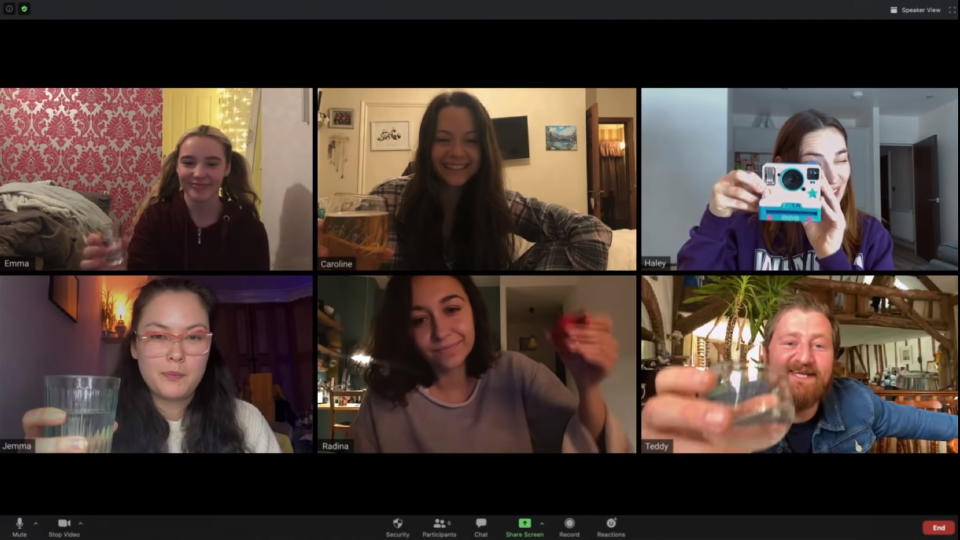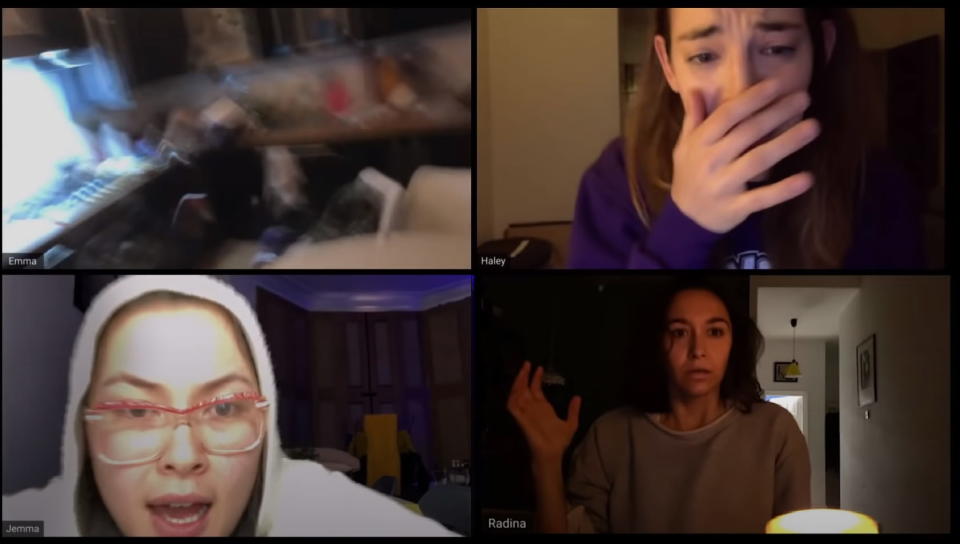Shudder's 'Host' finds the true horror in pandemic Zoom calls
What's scarier, audio feedback or a ghostly attack?
Just when so many of us have become desensitized to the mundane horror of never-ending Zoom meetings and the isolation of quarantine, comes a movie that explores just that. Shudder’s Host follows a group of friends, each sheltering from the pandemic, as they conduct a virtual seance over Zoom. Surprise surprise, things go very wrong over its short 57 minute runtime. It’s a serviceable horror film, but Host’s true genius is how it reflects lockdown life, both through its narrative and its very existence.
The film starts with a Zoom call login (complete with manually selecting “Join with Computer Audio”). If you’re watching it on a laptop, it’s easy to mistake it for the ritual you may already be doing several times a day. We meet the main characters, a group of young Millennial women and their obligatory, wild guy buddy. Most are locked down in their apartments, but there are glimpses of the other ways people are sheltering in place. One girl invited her short-term significant other to stay with her, but they’re clearly already tired of each other. And the aforementioned guy friend is staying with his girlfriend’s parents in the country.
While we don’t spend much time with the friends before things get creepy, we see them deal with issues familiar to anyone living through the COVID-19 epidemic. There’s the frustration of wrangling an older parent who keeps going outside, even if a short walk may mean certain doom. The annoyance of joining a Zoom call properly (and the piercing sounds of bad audio reverb). Like the audience, they’re all clearly tired of this shit.

Once they all gather and start chatting with their virtual medium, she raises an intriguing concern: They’re more vulnerable to otherworldly influences because they’re conducting a seance remotely. They don’t have the spiritual protection of being in a room together. It feels like an apt metaphor for our current lives. Our friendships and relationships still exist, but it’s hard for those connections to give you the same psychological support when they’re occurring over video chats. (Maybe I just miss having casual drinks and coffee with friends.)
I’ve been hearing strange noises from my attic, so I called a few friends and went to investigate… pic.twitter.com/CxmJAf44ob
— Rob Savage (@DirRobSavage) April 21, 2020
The idea for Host came after director Rob Savage pranked his friends over a Zoom call, he told Rolling Stone. Savage gathered a group for moral support as he explored the creepy attic in his new apartment —but what they didn’t expect was for him to be attacked by a zombie, throwing him to the floor. He cut the Zoom recording down to a two-minute clip which, unsurprisingly, went viral on Twitter. Then came the calls for a longer spin on the concept, which led Savage to enlist writers Jed Shepherd and Gemma Hurley to write up a 17-page outline.
Shudder, an AMC-owned streaming service dedicated to horror, ended up being the perfect home for the film, Savage said. It gave him the freedom to shoot the film in order sequentially and in creative new ways. The cast shot themselves remotely, and also handled their own effects and lighting. Shudder was also open to something shorter than a standard 90-minutes.
Indeed, Host’s short running time is one reason it’s so impactful. It fits a ton of scares and character building into 57 minutes. If we spent any more time with these characters, as often happens with overcooked Netflix shows and movies, we might end up souring on the Zoom horror concept. The film’s scrappy production also lends itself to the creepy atmosphere. The cast had to shoot over consumer webcams and smartphones, so nothing is ever too clear, and you can tell they actually lived in the spaces they were filming.

Savage also had to come up with creative solutions for getting footage remotely. James Swanton, who plays the demon haunting our Zoom attendees, had his mother shoot his scenes on a smartphone. "He was isolating with his mum in the middle of Devonshire or something like that,” Savage told Rolling Stone. "And so we basically had to find bits of his house that looked like other characters’ houses so I could do kind of trick edits to make it seem like he was in the same space with them.”
Host clearly isn’t a big-budget affair — most of its scares are fairly low tech, and rely on the tension of what you don’t see. But even though it doesn’t reach the heights of other found footage films like The Blair Witch Project, Paranormal Activity, or even computer screen-based movies like Unfriended, it’s a fantastic example of art created under duress. It’s a movie that couldn’t have been made before the COVID-19 pandemic, but will likely be remembered as one of the best distillations of life under lockdown.
